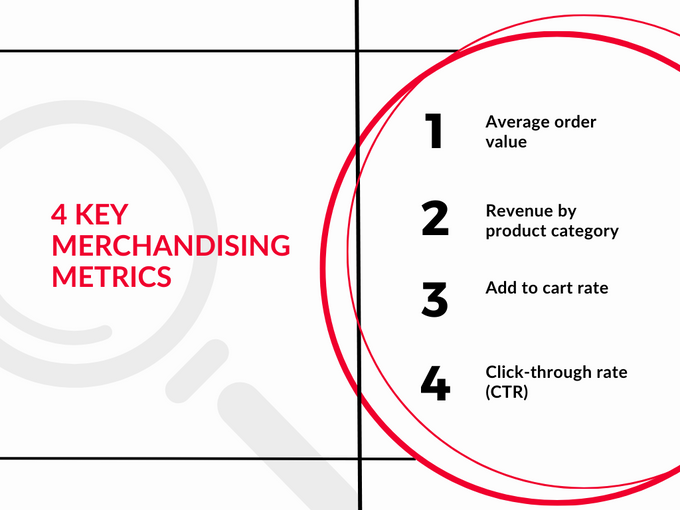Maximizing eCommerce Merchandising Metrics for Success
Elevate your eCommerce game with these essential merchandising metrics and strategies.
Updated November 19, 2024.

The world of eCommerce is fast-paced, and monitoring and adapting your merchandising strategies is crucial for staying competitive. Below, we explore how to maximize your eCommerce merchandising metrics for success by discussing:
- Key merchandising metrics
- Tools that can help you track merchandising metrics
- What to do if your conversion rates drop
- How to prioritize merchandising with limited resources
Meet the Expert
Jameela Ghann is a seasoned online store owner with over a decade of eCommerce experience. Apart from running Alora Boutique, she's also the marketing manager for Fera Product Reviews.
Unlocking eCommerce Success with 4 Key Merchandising Metrics
1. Average Order Value (AOV)
AOV measures how much customers spend in a single transaction. The typical formula is:
AOV = Total Revenue / Number of Orders
A rising AOV indicates you're using effective cross-selling or upselling strategies. To further boost AOV, consider:
- Offering product bundles
- Showcasing related items
- Providing discounts on higher-priced products when customers purchase multiple items
2. Revenue by Product Category
Evaluating the revenue each of your product categories generates can help you understand your store's performance better. This metric helps identify thriving areas and those needing more attention. Focus on successful categories to optimize your merchandising efforts for maximum impact.
3. Add to Cart Rate
This metric tracks the percentage of visitors who add products to their cart. The typical formula is:
Add to Cart Rate =
Visitors Who Added Products to Cart / Total Number of Visitors
It highlights the appeal of your merchandised products. If add-to-cart rates are low, optimize product descriptions, images, and calls to action to entice visitors towards a purchase.
4. Click-Through Rate (CTR)
CTR measures how many users clicked through to a specific destination, like a landing page. The typical formula is:
CTR = (Number of Clicks / Number of Impressions) x 100
Analyzing how many users click on product recommendations and links is essential to assess how effective your visual merchandising and product placement are. A high CTR indicates successful merchandising efforts in capturing users' attention.
Tools to Help You Track Merchandising Metrics
- Google Analytics (GA) GA provides robust insights into website performance, user behavior, and traffic sources. This way, you gain a deep understanding of how merchandising influences user behavior.
- Your eCommerce Platform's Built-in Analytics Your chosen eCommerce platform offers specific insights into your online store's performance, including sales, product views, and cart abandonment rates. These tailored analytics tools cater to your store's unique data.
» Find out how Fast Simon's merchandising solution can help you optimize your merchandising efforts
Scenario: Dealing with a Drop in Conversion Rates
Now, imagine a scenario where a business notices a drop in conversion rates. What steps should they take based on their conversion metrics?
- Identify the Specific Drop Pinpoint where the drop in conversion rate occurs in your sales funnel. Is it during checkout, when users add items to their cart, or at the homepage?
- Shop Your Own Store Navigate your website as a customer. Look for any friction points, like broken buttons or confusing navigation. These often-overlooked issues can significantly impact conversions.
- Review Google Analytics Analyze data and compare performance periods. Look for changes coinciding with the conversion rate drop. Examine traffic sources, as irrelevant or low-quality traffic can impact conversion rates.
- Examine User Behavior Study how users navigate your website. Tools like Lucky Orange provide valuable insights into user interactions and areas where they drop off. Optimize your website to enhance the user experience and prevent negative website interactions.
- Check for Product Availability Ensure users can find what they're searching for. If a specific product isn't available or tagged correctly, it can lead to dissatisfaction and lower conversion rates.
- Evaluate the Checkout Process Pay special attention to the checkout process, where conversions often drop. Ensure it's smooth, user-friendly, and free from any technical glitches.
- Ask for Customer Feedback Reach out to your customers for feedback if the issue isn't identified. They might provide insights into what's causing the drop in conversion rates.
By starting at the checkout process and working up the funnel, you can systematically diagnose and address the issue affecting your conversion rate. Customer feedback can be invaluable in understanding their experience and improving your eCommerce site.
» Need a headstart? Explore how AI can improve eCommerce conversion rates
Product-Specific Considerations
Product-specific issues can have a significant impact on conversion rates. Consider these scenarios:
- Traffic from viral content: Viral content may attract visitors who aren't necessarily interested in purchasing, leading to high traffic but low conversions. Align audience intent with your product to improve conversion rates.
- Variant availability: Incorrectly marking a product as sold out when only one variant is unavailable can cause confusion. Ensure accurate availability information to prevent cart abandonment.
- Negative reviews: Multiple negative reviews for a specific product can significantly impact conversions. Prioritize addressing concerns and maintaining product quality.
5 Ways to Prioritize Merchandising with Limited Resources
- Focus on High-Converting Products Focus on products with a strong history of conversions, customer interest, and relevance. Ensure product pages load quickly to prevent user frustration.
- Optimize Visual Merchandising Invest in high-quality visuals for key products. Ensure images load swiftly, as slow-loading visuals can drive potential customers away.
- Prioritize AOV Determine which products contribute most to revenue and focus on strategies to increase AOV. Cross-selling and bundling related products can be effective tactics.
- Inventory Management Prioritize selling or bundling slow-moving inventory to free up resources.
- Optimize Product Pages SEO Implement effective SEO strategies for each product page to enhance visibility in search results and lead to higher conversion rates over time.
» Discover more eCommerce merchandising strategies and best practices here
Elevate Your eCommerce Success
eCommerce merchandising metrics are essential for measuring success and guiding your strategies. Regularly monitor these metrics, diagnose and address issues affecting conversion rates, and prioritize your efforts to achieve the best results for your eCommerce business. By doing so, you can continually optimize your merchandising approach and stay competitive in the ever-evolving eCommerce landscape.





